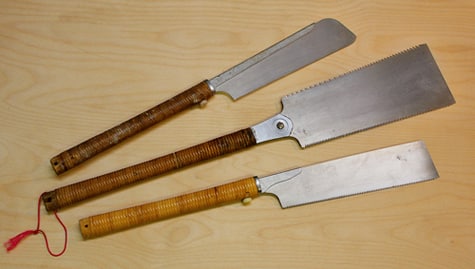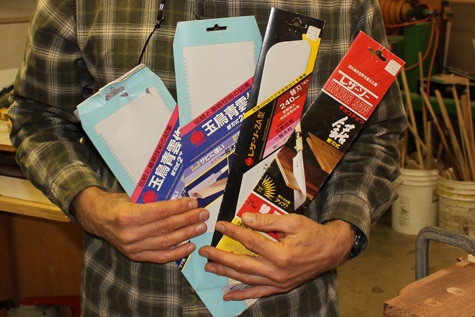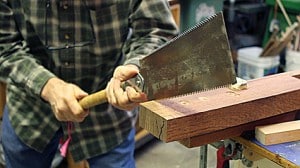The Gyokucho brand Japanese saw is the best overall value.

I have given up on western style push saws unless they are tensioned blade saws like a hacksaw or bow saw. Standard western saws without a blade stiffener have to be very thick and stiff to overcome the blade wanting to bend and fold on itself during the push motion through the stock. They even wear me out, and I am fairly strong and coordinated. There are of course some very fine western style back saws and dovetail saws with blade stiffeners, but these tend to be very expensive. I have actually owned some of these but have been very disappointed in the cost to performance ratio. I’ve tried to resharpen the teeth myself as well as paying a sharpening service, with very poor results.
Japanese saws are my choice for woodworking, and have been for many many years. I come from the “let’s get on with it” school of woodworking. I want to do good precise work, but I don’t want to fuss over a consumable tool like a saw. For me hand saws are consumables like sandpaper. I won’t make big monetary and emotional investments in handsaws, unlike say a special square and ruler set, or a good hand plane, both of which will last a lifetime.

I do not refer to these saws by their Japanese names because I feel ridiculous trying to pronounce them. Fortunately it doesn’t matter what I call them, what matters is how they cut.
These saws cut like nothing you have ever used before, and I think they are one of the best values in woodworking tools.
In my four part Japanese Saw video series I show the three different saws I use on a daily basis. Two of the handles are well over twenty years old. When the blade dulls I can easily order a replacement blade from Japan Woodworker. The replacement blades generally last me about two to three years.

If you could only purchase one Japanese saw, buy this one:
Carpenter’s Saw – Ryoba Noko Giri – Gyokucho brand RazorSaw – A double edged saw
Handle and 12″” blade: #19.616.0 $41.00
Replacement blade only: #19.616.1 – $28.00
If you could buy two Japanese saws, add Allan’s favorite:
Crosscut Saw w/thicker blade – Kataha Noko Giri – Gyokucho brand RazorSaw -A single edged saw
Handle and 9.5″ blade: #19.410.0 $33.00
Replacement blade only: #19.410.1 – $17.00
For delicate furniture work, like dovetails, this works best:
Dovetail Saw/Crosscut Saw – Kataha Noko Giri – Gyokucho brand RazorSaw -A single edged saw
Handle and 9.5″ .3mm blade: #19.300.0 – $42.00
Replacement .3mm blade only: #19.300.1 – $21.00

WoodMan’s First Japanese Saw


Of course there are times when you have to have the handle up. Namely when cutting wide pieces or panels where the blade is unable to span the distance. When I’m working with a piece of this size I just use my panel saw or my table saw. Japanese saws for me are used for joinery and cutting billets of wood for a specific project.
The Japanese saw looks strange if you’re not familiar with them, but for the price, you can’t afford not to give them a try.
I highly recommend the Gyokucho RazorSaw brand of Japanese pull saw. I bought my first one 26 years ago. It still has the original handle and I use it every day.
I just made my first video series demonstrating Japanese hand saws. If you watch the videos in this post you’ll get an introduction to using these invaluable tools. You’ll see me hand cut a tenon, rough cut a board and quickly change the blades.

Great saw,,i love it but in my country(indonesia)hard to getit
“Dudes do not appreciate being told they are cutting like a kid.” Priceless. Goes to the top of my Best Quotes from real people on line” list. Probably worth of a t-shirt in fact.
hi Allen, great video,s have had two pull saws for years now and will not use anything else.Hardware stores do not stock them here in Australia which is a pity as once you have used on you will not want to go back to the push type saws .
Hi Chris,
I couldn’t agree more about pull saws. Sorry to hear they are difficult to get in Australia. Thanks for the comment and glad you like the videos!
I just bought a wood working book for kids for my friend’s son who is five turning on six. One of the tools the book talked about was the Japanese hand saw and how it was easier to use in comparison especially for kids.
I see that certain home improvement stores have a line of hand saws that are based upon the Japanese ones. They are considerably cheaper then ordering saws that identify themselves as Ryoba and Dōzuki. But is the quality the same as the ones from Japanese manufacturers?
Hi Allan,
A lot of good info here and on your youtube channel. After watching one of your videos, I started using pc-7 epoxy and I have to say it’s the only way I glue anything complex now! Thanks for sharing it.
I bought a used ryoba on ebay recently. I am no stranger to Japanese saws having used a dozuki for many years. But this is the first time I have handled a “resharpenable” ryoba and I must say I was shocked at how thin the blade is. It bends with almost no effort. Being so thin, it is prone to flopping around while sawing. I am wondering if this particular saw is somehow inferior. Any thoughts?
Thanks
Hi Phil, I have used the Japanese saws for a long time but I do not consider myself an expert by any measure. The thinnest I have is the .3mm fine crosscut with the stiffener. I have another medium crosscut that is .5mm with no stiffener. It cuts very well and very straight. I have always stuck to Gyokucho brand with the replaceable blades. I have one of the special files for sharpening, but have not had worthwhile success with resharpening. The replacement blades are so reasonable and last so long, that I just go that way. Your saw may be some type of specialty saw for very thin veneer or stock therefore the very thin blade. I buy the general purpose saws for my type of work.
Hi, my father left me his tools as an heritage, but never had the time to explain me how to use some of them. Even if we always had japanese saws at home since I was a kid, I’ve never figured it out how to use them properly. So big thanks.
Cheers.
Frank, I am glad you found some information of value here. That is really great you are using the tools your father held in his own hands.
Gyochucko or Gyokucho?
Gyokucho
What is your opinion of using the ryoba for long rips (deeper than the blade width). I’ve heard some people say the crosscut teeth on the tailing edge can slow the cut or interfere with tracking. Has this been your experience, or are you able to cut long rips without any problem? Thanks.
I rarely make rip cuts like you are describing since I am fortunate enough to have a whole selection of power tools for ripping operations. But whenever I have used a two sided saw for the cuts you described, there is definitely interference from the opposite side teeth while passing through the material. There are single edge Japanese rip saws available. They have specialty saws for every operation. I only have five styles but they do an incredible variety of jobs.
Hi Allan, thank you for the videos and this post. I bought my first house (a fixer), and am new to everything. Not interested in power saws and have been intrigued w/Japanese hand saws for a few years. Just to keep things simple and clear for me, would the Ryoba be good to use for things like floor moulding, closet rods, 2×4, 2×6 etc.? Thanks again!
A ryoba is the first Japanese saw one should buy in my opinion. It is a great all around choice because of the rip and crosscut capabilities. I don’t consider them saws for fine work but do they ever just let you get on with your projects. They really shine at quick aggressive cuts in a pinch. In the Tenon Cutting Videos I used one to make some fairly accurate cuts for an aggressive saw. You will be very happy with one.
Thanks for the post.Thanks Again. Will read on…
Thanks for writing. I have over 300 videos on YouTube about woodworking. Some may be of interest to you. Thanks again and keep in touch.
I’m about to make a canoe out of 4mm ply.
Which saw would you recommend for this?
Since you will mostly be cutting sheet stock, I would think the saw #19.410 would be best. The two sided saw is just too big and rough for plywood. And the fine crosscut has the blade stiffener that will impede cuts. I love canoes. i have steam bent white oak for gunnels several times. I have a Wenonah MN III that is just awesome. It is the only thing I have ever bought that is perfect in every way. Please document your canoe project and send me pics to my askwoodman @ gmail email. I am very interested in every aspect of this exciting project. Keep in touch.
Hi,
I really enjoyed watching your videos on Japanese saws.I’m planing to buy them and begin use them, but I don’t know how, and then I found your videos on YouTube, subscribed to your channel and come here. And I will come again and again, great site you have.
So, WoodMan, consider yourself as my Japanese Saws Teacher.
Thanks a lot
Leo Basic, Zadar, Croatia
Hi Leo, Thank you for such a positive comment. Japanese saws are pretty amazing. Remember to let the saw do the work and do not try to force those thin blades through the work. That is how I ruined blades when I was young. I am glad you found information from my site you found useful. Keep in touch have a great summer in Croatia.
Hi Allan, I enjoyed watching your videos. I was very fortunate many years ago, to learn to use Japanese woodworking tools from a master shoji screen maker. The way you rip e.g. cutting tenons is the same method that I use. However, when I cross cut, I usually start from the edge away from me and cut back towards me. This has the advantage of being able to follow your cutting line easier, improving your accuracy. As I cut through about 1/3 the thickness, I rotate the wood 90 degrees away from me, thus exposing more cutting line (assuming that you have marked your wood on all 4 sides as the Japanese tend to do). I do this on all 4 sides of the wood, eventually cutting through the wood. This method works better on wood where the width and depth are closer in size as opposed to a wide, thin board. Please give it a try as it may improve your accuracy and let me know what you think.
I thoroughly enjoyed watching your videos on Japanese saws. I was particularly impressed with their precision and speed. Though it isn’t perfect, it far more than I would expect from a standard western saw. I vaguely remember trying to use one several years ago to ill effect, but I clearly wasn’t using it correctly. I will be asking my wife for a set for Father’s Day. Looking forward to seeing more videos on the use of these saws. Thanks for your work.
Hi Daniel You are correct it is not perfect, but the two sided saw is a rough carpentry saw just designed for getting after it. I just wanted to show how these saws can be used in a pinch to make some pretty good cuts. I would always choose to use a combination of my power tools to cut a tenon, but for quick cuts in the shop, and we both know there are no shortage of them, these saws do a great job. I think those Gyokucho brand saws are one of the best values in woodworking. The main thing when you get your new saw is to let the saw do the work. Since the blades are so thin, applying too much pressure can lead to a drifting cut. I liken the grip almost to the grip of a pool cue. Not a death grip, but a supple guiding of the handle in a linear motion. Get a piece of poplar to practice with. That is such a great wood learn with. It is the wood I cut my teeth on and still use in my shop for all kinds of applications. Keep in touch and happy Father’s Day.
Hi Eric, The image of six inches off the ground and ergonomic made me chuckle.
Hey Allan, thanks for your great videos and insights into Japanese saws. I have 2 Gyokuchos and they’re just the bomb. Thanks for the links to specific saws as well. My ryoba is perhaps too small for the beefy cuts I sometimes make – I think that carpenter saw would do the trick. The other one I got was a dovetail saw (dozuki) but the teeth look much more like the crosscut saw and I wonder if that dozuki wouldn’t do just fine for my fine crosscut work.
On another note, one disadvantage of the form you use when cutting seems to be that you have less control over fine-tuning the path of your cut, once you’ve started (since the blade is kind of moving over the cutline in reverse). I made some Japanese sawing trestles which are only 6″ off the ground, and using those you can have the best of both worlds: controlling your cut as well as working ergonomically. Of course, I don’t always follow my own advice – look at how dumb this looks!
Hey great demo. How do you keep your cuts straight? I got this saw for Christmas and I’ve been cutting tons of dovetails and tenons with it but it always drifts left or right, almost like the swing of my arm during the cuts.
Are there any tips for holding the saw or am I doing something wrong?
Thanks again for these demos!
Will
Hi Will
I think the secret to cutting accurately with these saws it to let the saw do the work. For rough bucking of stock you can power through your cuts, but when when striving for precise cuts you merely guide the saw with a really relaxed grip and stroke. I always put a pencil or scribe line to guide my cut also. And whenever possible, always try to have the handle as low as possible. This helps reduce that side to side tilt of the blade that can throw cuts off. By allowing the saw to do the work without extra pressure, the saw wants to go in a straight line. It is the path of least resistance. What can also throw a cut out of straightness is grain direction within the cut especially in end grain cuts. Here is where a light touch can keep the blade from being improperly channeled along a grain line instead of your work line. And what you will find is that once you aquire this light touch, you will make faster cuts with a lot less effort. I am going to make more Japanese saw videos soon. Thanks for watching and commenting. Keep in touch. Allan
Hi Allan, I remember seeing you use these for the first time in your shop last year. You sure make them look easy.
Pretty interesting Allan. I have never used a Japanese saw, but I think I may have to get one. Nice post.